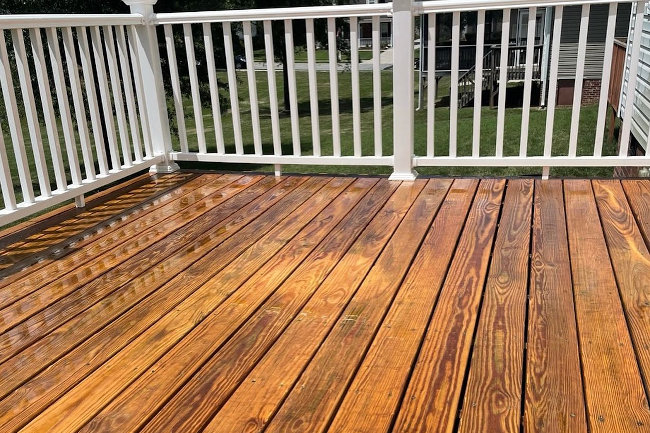Preserve and Protect: Let Loose the Power of Fence Staining
Choosing the Right Stain for Your Fencing: Tips and Considerations
When it comes to enhancing the appearance and maintaining of your fence, selecting the best discolor is crucial. We will check out the various kinds of fencing spots, factors to think about before selecting a stain, suggestions for preparing your fencing for discoloration, and the distinctions in between water-based and oil-based discolorations. Furthermore, we will certainly dig right into selecting the best stain color to complement your fencing and boost your exterior area.
Understanding Different Kinds of Fencing Spots

On the other hand, water-based spots are made from acrylic or latex and supply a more subtle color to the timber. They develop a safety film externally of the timber, protecting against moisture from seeping in and securing versus UV damages. Water-based spots are easier to clean up and have a quicker drying out time contrasted to oil-based discolorations. They are additionally less likely to fade or break with time.
Picking in between oil-based and water-based stains depends on various factors, including personal choice, the wanted appearance, and the degree of maintenance required. Oil-based discolorations are advised for fence high-traffic locations or those constantly exposed to severe climate condition. fence staining and sealing. Water-based discolorations, on the other hand, are a prominent choice for fences in houses where look and ease of use are necessary
When picking the appropriate discolor for their fence,Recognizing the distinctions between oil-based and water-based discolorations assists property owners make an informed choice. Considering the details demands of the fence, such as its location, direct exposure to sunlight, and preferred aesthetic, will certainly make sure that the chosen tarnish gives durable security and boosts the general elegance of the fence.
Factors to Consider Prior To Choosing a Spot

Various types of timber absorb spots differently, resulting in differing levels of color intensity and sturdiness. Furthermore, certain timbers may be extra susceptible to concerns like rot or insect infestation, which might impact the choice of discolor to shield and preserve the fence.
The climate and weather in your area should likewise be considered. You may require a tarnish that supplies additional security against wetness and UV rays if you live in an area with severe winters months or high moisture. Also, if your fence is subjected to direct sunlight for long periods, a stain with UV inhibitors can help prevent fading and staining.
Finally, it is necessary to consider your desired visual. Various spots offer various shades and surfaces, allowing you to personalize the appearance of your fence (deck staining). Consider the total design and style of your residential or commercial property, as well as any kind of regional policies or property owner organization standards that may dictate the appropriate stain shades
Tips for Preparing Your Fence for Discoloration
To prepare your fence for discoloration, begin by extensively cleansing the surface area using a moderate cleaning agent and a stress washer or scrub brush. Cleansing the fence is an important action as it removes dust, grime, and any previous coverings that might hinder the discoloration process. Begin by moistening the fence with water and after that apply a light detergent making use of a scrub brush or a pressure washing machine with a low-pressure setting. Rub the surface carefully, paying added attention to locations with stubborn discolorations or mold. Wash the fence completely with tidy water to remove all traces of cleaning agent.
This action is essential as tarnishing a wet or wet surface area can lead to poor attachment and an irregular surface. Make certain that the fencing is completely dry before proceeding with the discoloration procedure.
Prior to staining, examine the fence for any problems, such as loosened boards or nails. Fix any type of problems to make sure that the fence is structurally sound. Furthermore, take into consideration using a timber conditioner or brightener to the surface area. This product helps to open up the timber pores, enabling the discolor to permeate better and uniformly.

Comparing Water-Based and oil-based Stains
When picking a stain for your fence, it is very important to compare the attributes and benefits of water-based and oil-based discolorations. Both types of spots have their very own benefits and considerations, so it is crucial to comprehend the differences in between them.
Oil-based discolorations are known for their toughness and resistance to use and tear. They pass through deeply into the wood, offering exceptional protection versus the elements. They also improve the natural appeal of the timber by highlighting its grain and structure. In addition, oil-based stains have a tendency to last longer than water-based spots, making them a prominent selection for fencings.
On the various other hand, water-based stains are extra ecologically friendly and easier to cleanse up. They may not provide the very same level of defense as oil-based spots, especially in harsh climate conditions.
Ultimately, the option between water-based and oil-based spots relies on your certain needs and choices. Consider aspects such as longevity, environmental impact, and convenience of application when making your decision. Consulting with a specialist or seeking suggestions from experts can likewise aid guarantee that you select the appropriate stain for your fence.
Selecting the Right Spot Color for Your Fencing
The selection of an ideal stain color for your fencing is a crucial aspect of improving its visual appeal and matching the total design of your outside area (fence staining and sealing). The ideal stain color can change a plain, average fence right into a striking prime focus that adds depth and personality to your residential property
When choosing a tarnish color for your fencing, it is necessary to consider the design have a peek at these guys and design of your home. Earthy tones such as neutrals and browns can create a cozy and welcoming appearance if you have a classic or conventional design home. On the various other hand, if you have a contemporary or modern home, you may consider choosing vibrant and dynamic colors that make a declaration.
An additional element to think about is the natural environments of your residential or commercial property. If you have a whole lot of plant, a tarnish color that matches the all-natural landscape, such as greens or deep reds, can produce a unified and cohesive appearance.
Additionally, it's worth taking into consideration the upkeep needed for different stain colors. Lighter colors have a tendency to reveal dust and put on even more easily, while darker colors can hide flaws and need much less constant touch-ups.
Inevitably, the selection of stain color for your fence must show your personal style and choices - fence staining companies. Take the time to consult and discover different alternatives with professionals if needed, to make sure that you choose the excellent discolor color that enhances the charm and charm of your fencing
Conclusion
In conclusion, when it comes to selecting the appropriate tarnish for your fencing, it is essential to understand the different kinds of stains offered and think about aspects such as resilience and desired look. Preparing the fencing appropriately prior to discoloration is vital for accomplishing optimum outcomes. Furthermore, contrasting oil-based and water-based stains can help determine the very best alternative for your specific demands. Lastly, selecting the right stain shade can boost the general visual appeals of your fence.
We will check out the different kinds of fence stains, aspects to consider prior to selecting a tarnish, ideas for preparing your fence for discoloration, and the differences between water-based and oil-based spots.Separating between water-based and oil-based spots is crucial when recognizing different kinds of fence stains. Water-based spots are less complicated to clean up and have a much faster drying time contrasted to oil-based stains. Furthermore, oil-based stains have a tendency to last longer than water-based discolorations, making them a prominent selection for fences.
In final thought, when it comes to picking the right tarnish for your fence, it is crucial to understand the different kinds of discolorations available and think about factors such as resilience and wanted appearance.